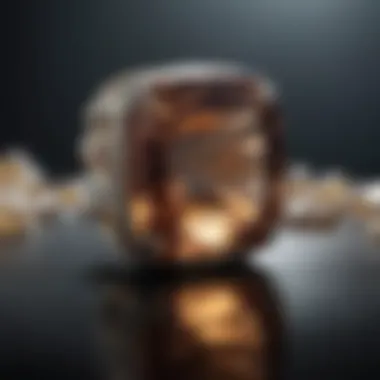Exploring the Fascinating Aspects of Scapolite Stone


Intro
Scapolite stone, a lesser-known but fascinating mineral, often finds itself overshadowed by more famous gems and rocks. However, its unique properties and rich geological background deserve a spotlight. For rock and fossil collectors, understanding scapolite is not just about appreciating its aesthetics but also grasping its origin and uses. This mineral serves as a perfect case study for anyone interested in the complex dance between nature and human interest.
As we embark on this exploration, we will traverse through its history and origins, the methods for identification and classification, as well as its role in jewelry and healing practices. Each facet tells a story, one that's rooted deeply in natural history and mineralogy.
History and Origins
Overview of Collectibles, Rocks, and Fossils
When thinking of collectibles, rocks and fossils often come to mind, forming a bridge between ancient earth and the modern collectors. Scapolite stone, with its striking colors and intriguing characteristics, fits well into this continuum. Found in diverse locations across the globe, such as Canada, Madagascar, and the United States, it's collected not just for its beauty but also for its geological significance. The excitement of discovering a scapolite specimen goes beyond aesthetics, allowing collectors to connect with the planet's geological chronicles.
Historical Significance and Cultural Impact
Throughout history, scapolite’s unique properties have intrigued not only scientists but also various cultures. It has been historically attributed with various healing properties; many believed it to foster communication and assistance in decision-making. Some cultures even regarded it as a stone of spiritual awakening, making it a favored choice among practitioners of alternative healing.
According to several sources, including the auspices of connections formed in both geology and anthropology, scapolite has made its way into the cultural fabric of societies as a talisman or a decorative item of choice. For collectors and historians alike, knowing the background of this gemstone can deepen the appreciation for its beauty.
"Understanding the origin of a mineral enrichens the value and the meaning attached to it."
In today’s market, collectors find scapolite to not just be a beautiful addition to a collection but also a piece of history that exudes character. Whether as a stunning display piece or used in healing practices, its versatility and the fascinating historical ripple it has created keeps collectors coming back to explore more.
Identification and Classification
Guide to Identifying Rocks and Fossils
For enthusiasts keen on identifying scapolite, first look for its glassy luster and its often transparent to translucent quality. One might notice shades ranging from creamy whites to vibrant yellows, and even deep purples. This variety in color is crucial when distinguishing scapolite from other semi-precious stones that might resemble it. Typically, scapolite can be found in either a prismatic or a granular form.
Common Types and Variations
Interestingly, scapolite exists in multiple forms, each presenting its own characteristics. Notable varieties include:
- Marialite: Usually found in lighter shades such as white or yellow, it’s mainly appreciated for its clear appearance.
- Meionite: Typically darker and often displays more complex color gradients that can fascinate collectors.
- Scapolite Cat's Eye: Rare and valuable, this type exhibits a unique optical phenomenon, making it highly sought after in the market.
Each of these types reflects different geological environments in which they form, further enriching the narrative attached to scapolite stones.
In summary, scapolite offers a wealth of information and aesthetic appeal that captures the essence of earth's history and cultural significance. For collectors, this mineral is not only about its beauty but also its story, forming a connection to the geological tapestry and cultural narratives that span thousands of years.
Preamble to Scapolite Stone
Scapolite stone is a mineral that sits at the intersection of beauty and geological wonder. For anyone interested in collecting stones or just learning more about the earth's treasures, understanding scapolite is vital. This mineral, with its striking colors and unique attributes, offers insights into the forces that shape our planet.
Defining Scapolite
Scapolite, primarily found in metamorphic and igneous rocks, belongs to a family of silicate minerals. It consists of a complex structure made up of sodium, calcium, aluminum, and silicate groups. Think of it like a chemical cocktail, each ingredient playing a crucial part in its overall composition. Often mistaken for other stones, it showcases an array of colors, ranging from pale yellow to blue and even mauve. The nuances within these shades speak volumes about the conditions under which the scapolite formed.
This mineral is unique, not just in its looks but also in its physical properties. Its crystals can form in different shapes, such as prismatic or tabular, giving it an interesting appeal for collectors. When discussing scapolite, it's not just about the aesthetics; its structure and composition make it a fascinating topic in the realm of geology.
Historical Significance
The history of scapolite is as rich as the mineral itself. Discovered in the 19th century, scapolite gained attention among mineralogists due to its striking appearance and varying compositions. Some ancient cultures believed that specific stones held mystical properties, and scapolite was no exception. Its vibrant hues were associated with various meanings, and many believed it brought luck, healing, or even protection.
In addition to its symbolic significance, scapolite has been an important mineral for geologists and gemologists. From a scientific standpoint, its presence can indicate specific geological environments, giving researchers clues about metamorphic processes. As a result, scapolite not only serves as a valuable collectible but as a key indicator of the earth's dynamic processes.
"Scapolite not only enchants with its beauty but also provides a window into Earth's geologic past."


In summary, scapolite is more than a pretty face in the mineral world. Its diverse characteristics and historical relevance make it a topic worth exploring for anyone keen on geology or mineral collection. Through understanding scapolite, one gains insight into a larger narrative about nature's artistry and the earth's geological history.
Formation and Geological Context
Understanding the geological formation and context of scapolite is crucial for grasping its unique characteristics and value in both the mineral collection community and various industrial applications. Scapolite forms under specific conditions and is often found in metamorphic rocks, which not only highlights its rarity but also provides insight into the geological processes that create such fascinating minerals. This section seeks to illuminate the important aspects of scapolite’s formation, offering rich detail on its mineral composition and the geological processes influencing its existence.
Mineral Composition
Scapolite is a complex mineral that contains a mix of aluminum, silicate, and carbonate, along with elements like sodium and calcium. The general formula can be represented as [ \textNa_4\textAl_3\textSi_9\textO_24\textCl ] or [ \textCa_4\textAl_3\textSi_9\textO_24\textCO_3 ]. This dual composition often leads to two main varieties: marialite and meionite. Each variety not only poses different aesthetic qualities but also varies in terms of geological stability and usage.
The interplay of these elements gives rise to scapolite's characteristic crystal structure and vibrant color variation, ranging from clear to various hues of yellow, blue, or even violet. Consequently, understanding its mineral composition is essential for enthusiasts and collectors who seek to determine the authenticity and rarity of the specimen. Moreover, discerning the differences in composition assists in evaluating its corresponding market value—something collectors and investors keenly keep an eye on.
Geological Processes
The formation of scapolite involves unique geological processes. Often, this mineral is discovered in environments marked by high temperatures and pressures typical of metamorphic terrains — think mountain belts or areas undergoing regional metamorphism. Scapolite typically forms from the alteration of feldspar minerals when subjected to such extreme conditions.
Several geological scenarios can enhance the probability of scapolite’s occurrence:
- Metamorphism of sedimentary rocks: Where limestone or dolostone transforms under pressure and heat, creating scapolite in the process.
- Fluxing fluids: These play a significant role as they introduce different chemical elements, further contributing to the diverse nature of scapolite when it crystallizes.
- Alkalic environments: Sites with an abundance of sodium and potassium minerals can lead to favorable conditions for the formation of scapolite crystals.
Understanding these processes doesn’t just tell us how scapolite comes into existence; they also reveal the environmental shifts that have occurred over millennia. This is vital for collectors interested in the stories behind their specimens—stories that are simply wrapped in the intricate details of Earth’s geological history.
"Each facet of a scapolite stone tells a tale of transformation, indicating the dramatic shifts in Earth’s crust that crafted it into existence."
Through these geological insights, enthusiasts gain a deeper appreciation for scapolite��—not simply as a beautiful mineral but as a piece of nature’s history, laden with transformations that retrace the Earth’s story through time. The significance of scapolite extends beyond its beauty; it is a testament to the geological wonders that shape our planet.
Physical and Chemical Properties
Understanding the physical and chemical properties of scapolite is vital for anyone intrigued by this fascinating mineral. These characteristics influence its behavior, usability, and value in various applications. Grasping these elements not only aids collectors but also enriches the knowledge base for those interested in geology and mineralogy.
Crystal Structure
The crystal structure of scapolite can be visualized as intricately arranged units, with a distinctive framework that exemplifies its uniqueness. This mineral typically belongs to the tetragonal system, presenting intricate symmetrical patterns that reflect its internal atomic arrangement.
When viewed under a microscope, the beauty of scapolite truly comes alive. You can see well-defined prisms that often manifest as elongated, columnar crystals. Each facet of these crystals gleams, revealing hints of its internal make-up. These structures are essential for gem cutters and collectors, as they impact the stone's optical properties and enable it to take on brilliant finishes.
Color Variations and Characteristics
Scapolite exhibits an alluring range of color variations, making it a versatile gem. From pale yellow and honey hues to rich purples and deep blues, its spectrum resembles the colors one might find at sunset.
These colors stem from minor impurities present during its formation. For instance, a slight presence of iron can lead to darker shades, while its clear varieties tend to showcase light colors.
Here are some characteristic colors and their implications:
- Yellow Scapolite: Often used in jewelry due to its attractive brilliance.
- Purple Scapolite: Considered rare and sought after by collectors, often fetching higher prices.
- Gray Scapolite: Commonly encountered, but less favored for decorative uses.
The interplay of these colors can dramatically enhance the visual appeal of a collected specimen and significantly influence its market value.
Hardness and Durability
Hardness and durability are key factors that every collector and enthusiast should consider. Scapolite ranks between 5.5 to 6 on the Mohs scale, which suggests it is relatively soft compared to other gemstones. This assures a certain level of fragility that can be a point of concern unless handled carefully.
Despite its moderate hardness, scapolite's beauty makes it a popular choice in jewelry, though it may require special care to prevent scratches or damage. Here are some considerations:
- Avoid harsh chemicals: Substances like bleach can damage its surface.
- Store separately: Ensure it’s kept away from harder stones to prevent scratching.
- Regular cleaning: Use mild soap and water, avoiding abrasives that may wear down its luster.
In summary, while scapolite may not be the hardest of minerals, understanding its characteristics allows collectors to appreciate its beauty without compromising its integrity.


“Grasping the properties of scapolite opens up a more profound understanding of its place in natural history and its intrinsic value.”
Types of Scapolite
Understanding the various types of scapolite is crucial for anyone interested in rock and mineral collecting. Each type carries its own unique characteristics, which not only add diversity to collections but also influence their applications. For instance, the two primary varieties of scapolite, Marialite and Meionite, demonstrate distinct chemical compositions and properties that make them relevant in different contexts, from jewelry making to healing practices.
Marialite vs. Meionite
The first primary division in scapolite types can be drawn between Marialite and Meionite. Marialite is known as the sodium-rich variety, while Meionite is the calcium-rich counterpart. Their differences don’t just lie in their sodium and calcium content; they also showcase variations in color and clarity, which can be strikingly apparent.
- Marialite typically leans towards a more pleasing color palette. It can be found in shades of light yellow to clear and may even exhibit a touch of blue or lilac. This variety’s aesthetic appeal is often why it is favored in jewelry designs, where brilliance and clarity really count.
- Meionite, on the other hand, frequently appears in shades of orange, pink, and brown, making it visually distinct. The less common Meionite can be rarer in markets, often appealing to dedicated collectors who seek out unique specimens with a rich hue.
Thus, knowing the differences between Marialite and Meionite not only enriches a collector's understanding but also aids in making informed purchasing decisions in markets where authenticity and quality vary significantly.
Variations and Rarities
Besides the prominent types of Marialite and Meionite, scapolite showcases a range of variations and rarities that are intriguing to both collectors and geologists alike. These variations may occur due to factors such as environmental conditions, geological processes, and the combination of other minerals during formation.
Some notable variations of scapolite include:
- Scapolite with inclusion: Sometimes, you may find scapolite specimens that contain minerals like quartz or biotite within them. These inclusions can enhance the visual appeal and often increase a stone’s uniqueness.
- Color zoning: A rare finding, certain specimens exhibit color zoning, where the color can change within the same crystal. This phenomenon can create a captivating visual effect.
- Rarity of location: Scapolite can often come from specific regions, like certain parts of Brazil or Canada, which can make various types more valuable due to limited geographic availability.
"The fascination with scapolite lies not just in its physical properties but in the story it tells through its formation and location."
In summary, grasping the types of scapolite, such as Marialite versus Meionite, and recognizing the range of variations and rarities can provide a more nuanced understanding of this intriguing mineral. For collectors, these distinctions can drastically affect market value, desirability, and overall appreciation for their specimens.
With each stone, there is a history waiting to be explored. The rich palette, the geological narrative, and the symbolic meanings contained within scapolite serve to enhance the importance of knowing what one is hoping to collect.
Uses of Scapolite Stone
Scapolite stone is not just a pretty face in the mineral world. Its versatility drives a multitude of uses that span various fields, from jewelry-making to alternative healing practices. Understanding the applications of scapolite can shed light on its value beyond aesthetics. This section digs into these diverse uses, helping collectors appreciate what they have on their hands and providing insight into how this stone fits into broader markets.
Jewelry Applications
Jewelry enthusiasts often seek unique materials to make their pieces stand out. Scapolite is gaining attention for its distinct colors and crystal formations. Notably, the vibrant yellows and purples of scapolite can add a pop to any jewelry collection.
- Craftsmanship: Artisans often incorporate scapolite into rings, necklaces, and earrings. Its refractive qualities can produce a remarkable sparkle, making it a desirable option for engagement rings or statement pieces.
- Customization: With its relatively high Mohs hardness, scapolite endures regular wear, which is essential for everyday items like rings or bracelets. The stone can also be cut into various shapes to fit specific designs, enhancing its charm.
- Collectible Value: Unique scapolite specimens, especially those with unusual hues or clarity, can fetch a premium price in collector markets, making them not just wearable art but also investment pieces.
Healing Properties
In the realm of metaphysical beliefs, scapolite has attracted attention for its alleged healing properties. Some practitioners believe that this mineral possesses energies conducive to emotional balance and spiritual growth.
- Emotional Balance: Scapolite is often attributed with nurturing qualities that promote peace and harmony. It’s thought to ease anxiety and stress, making it a welcome companion for those dealing with turbulent emotions.
- Chakra Alignment: Many users claim that scapolite can assist in aligning chakras, particularly the throat and heart chakras, encouraging better communication and compassion. This makes it a favored choice for crystal healing practitioners.
- Meditation Aid: The calming energy of scapolite is said to enhance meditation and mindfulness practices, allowing individuals to deepen their connections with themselves and their surroundings.
Industrial Applications
The industrial sphere may not be the first place one would think to find scapolite, but it actually has a fascinating role. Its mineral properties make it useful in various applications that may come as a surprise to many.
- Construction Materials: Scapolite can be used to produce cement and concrete alterations. Its mineralogical compositions enable it to contribute positively to the durability of these materials.
- Glass Manufacturing: Scapolite is sometimes included in the production of glass and ceramics due to its capacity to affect the end product's transparency and color. Its unique properties can deliver distinct aesthetic effects in architectural glass.
- Soil Reclamation: Certain forms of scapolite have been examined for use in soil remediation projects. Its ability to stabilize and encourage growth in degraded soils can be valuable, especially in environmental restoration sectors.
Scapolite is not merely an aesthetic stone; its rich history and applications in various fields highlight its importance in both natural and industrial contexts.
In summary, the uses of scapolite stone extend far beyond collectible appeal. From eye-catching jewelry to holistic healing and industrial applications, its multifaceted nature proves that this mineral holds more than just surface value.
Collecting Scapolite


Collecting scapolite stones is an enriching pursuit that invites enthusiasts to dive deep into the fascinating world of minerals. As one treads through this vibrant landscape, it's essential to understand what makes this mineral not just a subject of study, but also a cherished item for collectors. From identifying unique specimens to understanding market dynamics, the journey of collecting scapolite can prove rewarding both intellectually and financially.
Market Value Determinants
When diving into the realm of scapolite collecting, market value serves as a beacon guiding both novices and seasoned collectors alike.
Several determinants play a pivotal role in influencing this value:
- Color and Transparency: The vividness of the hue and the clarity can significantly impact a piece's desirability. Well-formed, transparent specimens that exhibit rich colors receive higher prices.
- Crystal Structure: Unique crystal formations can be a game-changer. Collectors often seek out pristine specimens that display striking geometric shapes.
- Rarity: While some varieties of scapolite are more common, others are considered rarities. The limited availability of certain types can exponentially inflate their value.
- Origin: The geographical source can add to a stone's appeal. Scapolite from specific locations, such as certain regions in Canada, often fetch a premium due to their geological context.
- Market Trends: Like any collectible, trends can shift. New interests, such as the rising popularity of healing properties, can play a role in increasing demand.
"Understanding market dynamics is key for a successful collection. Each stone tells a story that impacts its worth."
Tips for Collectors
Collecting scapolite can be a deeply fulfilling journey, but it's essential to navigate the waters wisely. Here are some practical tips for those venturing into this fascinating hobby:
- Educate Yourself: Take time to read about scapolite. Compare it with other stones and minerals, making sure to familiarize yourself with its characteristics. Resources like Wikipedia can be invaluable.
- Network with Other Collectors: Engage with communities such as those on Reddit or specialized Facebook groups. Sharing experiences can provide insights and tips you might not find elsewhere.
- Inspect Specimens Thoroughly: Look for signs of treatment. Natural stones might be altered or colored artificially, and understanding how to spot these can save you from making costly mistakes.
- Attend Gem Shows: These events are treasure troves for collectors. You can meet dealers, find unique specimens, and even get appraisals on pieces you already own.
- Focus on Quality Over Quantity: Aim for well-preserved, unique specimens. As the saying goes, it's better to have a small collection of stunning pieces than a large collection of ho-hum stones.
By keeping these points in mind, collectors can foster a more enriching and knowledgeable experience when delving into the world of scapolite stone.
Scapolite in Cultural Context
Scapolite holds more than just geological significance; it permeates various cultures, revealing profound connections to human emotion and creativity. From ancient rituals to modern artistic expressions, scapolite is intertwined with beliefs and traditions that stretch across regions and eras. Understanding its role in these contexts adds layers of meaning to the stone, enriching not only the collector's knowledge but also their emotional connection to this unique mineral.
Symbolism and Folklore
Throughout history, scapolite has been surrounded by a rich tapestry of symbolism and folklore. In many cultures, this stone has been perceived as a powerful talisman, believed to possess unique energies that can aid in personal growth and healing. For instance, some tribes in South America refer to scapolite as a stone that bridges the gap between the physical world and the spiritual realm. It is often used in rituals aimed at harnessing personal strength and unlocking potential.
In various folklore narratives, scapolite is seen as a symbol of transformation. Folklorists recount tales where wearers of scapolite experienced significant life changes, suggesting that the stone has the power to encourage shift in perspectives and facilitate growth. The idea that a simple stone could foster such profound transformations resonates with many, lending a deeper understanding of its place in personal histories and cultural practices.
Artistic Representations
The allure of scapolite does not stop at folklore; it has also left its mark on the world of art. Artists have long drawn inspiration from the unique hues and crystalline structures of this mineral. In sculptures and jewelry, the various shades of scapolite, ranging from soft pastel yellows to deep, vibrant purples, have been celebrated for their beauty and versatility.
Many artists and craftsmen incorporate scapolite into their work, aiming to evoke emotions and convey messages through the visual appeal of the stone. For instance, modern jewelry designers often select scapolite for its aesthetic qualities and the beliefs associated with it. They see it as a way to connect the wearer with the broader narratives of personal development and spiritual journey.
"Art is the most beautiful of all lies; scapolite serves as both an inspiration and a medium to merge reality with the ethereal."
Overall, the intersection of scapolite with culture, folklore, and art offers a valuable perspective on the stone's multifaceted nature. By recognizing its symbolic significance and artistic appeal, collectors and enthusiasts can appreciate not just its physical characteristics but also the rich stories that accompany its existence across time and space.
Ending and Future Perspectives
The exploration of scapolite stone not only highlights its intrinsic beauty and diversity but also underscores its various applications and cultural significance. This concluding section serves as a reflective lens on the information presented thus far, synthesizing the key insights to paint a comprehensive picture.
Understanding scapolite, in terms of its geological formation and multifaceted uses, can be particularly beneficial for rock and fossil collectors. Having knowledge about the types of scapolite, as well as their physical and chemical properties, equips collectors with essential tools for evaluation and acquisition of specimens. Additionally, recognizing its symbolism and artistic representations allows collectors to appreciate these stones beyond their monetary value.
"In every stone lies a story waiting to be uncovered."
As the study of scapolite evolves, so does our understanding of its potential and relevance in various fields. Its prominence in jewelry and healing practices marks it as a unique and versatile material, worth delving deeper into. The next phase of interest is to explore how scapolite may influence future designs in the jewelry industry and whether advancements in technology can highlight its healing properties further.
Summary of Key Insights
Throughout this article, several key points have emerged regarding scapolite stone:
- Geological Formation: Scapolite is formed in high-temperature environments, often alongside other significant minerals. Understanding its genesis is crucial for collectors.
- Physical Variations: From color to hardness, the diverse attributes of scapolite make it an intriguing subject for both aesthetic and industrial applications.
- Cultural Relevance: The stone carries historical significance, often woven into local folklore, thus enriching one's appreciation during collection.
- Market Dynamics: The value of scapolite can fluctuate based on rarity, quality, and market demand. Being informed on these aspects can enhance the collector’s journey.
Potential Developments in Scapolite Research
Looking ahead, the potential developments in scapolite research are both exciting and essential. Here are a few areas that might pave the way for new insights:
- Technological Applications: As technology advances, there may be innovative uses for scapolite in various industries, including electronics or sustainable practices.
- Healing Properties Studies: Ongoing research could substantiate claims about scapolite's purported healing energies, enhancing its appeal in holistic practices.
- Environmental Impact: Understanding how scapolite mining affects ecosystems can generate discussions around sustainable mining practices, important in today’s ecological context.
- Educational Outreach: Increased awareness through educational initiatives could foster a stronger community of collectors while promoting responsible harvesting of natural resources.
As we continue to delve into the fascinating world of scapolite, embracing both its ancient roots and potential future developments will enrich not only our collections but also our understanding of the natural world.



